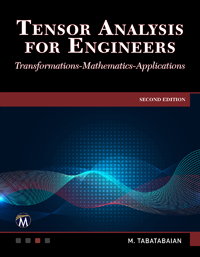 Tensor Analysis for Engineers 2E
Tensor Analysis for Engineers 2E
ISBN: 9781683926016
Pub Date: December 2020
Specs: 7 x 9 Paperback
Pages: 182
Price: $79.95
Tensor analysis is used in engineering and science fields. This new edition provides engineers and applied scientists the tools and techniques of tensor analysis for applications in practical problem solving and analysis activities. The geometry is limited to the Euclidean space/geometry, where the Pythagorean Theorem applies, with well-defined Cartesian coordinate systems as the reference. Quantities defined in curvilinear coordinate systems, like cylindrical, spherical, parabolic, etc. are discussed and several examples and coordinates sketches with related calculations are presented. In addition, the book has several worked-out examples for helping the readers with mastering the topics provided in the prior sections.
FEATURES
- Expanded content on the rigid body rotation and Cartesian tensors by including Euler angles and quaternion methods
- Easy to understand mathematical concepts through numerous figures, solved examples, and exercises
- Lists gradient-like operators for major systems of coordinates and rotation matrices for proper Euler and Tait-Bryan angles
BRIEF TABLE OF CONTENTS
1. Introduction. 2. Coordinate systems. 3. Curvilinear and oblique coordinate systems. 4. Basis vectors and scale factors. 5. Contravariant components and transformations. 6. Physical components and transformations. 7. Tensors – mixed and metric. 8. Metric tensor operation on tensor indices. 9. Dot and cross products of tensors 10. Gradient vector operator-Christoffel symbols. 11. Derivative forms-curl, divergence, Laplacian. 12. Cartesian tensor transformation-rotations. 13. Coordinate independent governing equations. 14. Collection of relations for selected coordinate systems. 15. Rigid body rotation: Euler angles, quaternions, and rotation matrix. 16. Worked-out examples. 17. Exercises. References. Index
ABOUT THE AUTHOR
Mehrzad Tabatabaian holds a PhD from McGill University and is currently Chair of the BCIT School of Energy Research Committee. He has published several papers for scientific journals and conferences, and he has written textbooks on multiphysics and turbulent flow modelling, thermodynamics, and direct energy conversion. He holds several registered patents in the energy field and currently teaches courses in renewable energy and thermal engineering.
